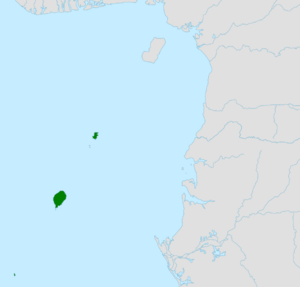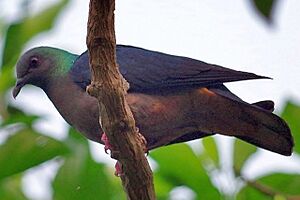Island bronze-naped pigeon facts for kids
Quick facts for kids Island bronze-naped pigeon |
|
|---|---|
 |
|
| São Tomé island | |
| Conservation status | |
| Scientific classification | |
| Genus: |
Columba
|
| Species: |
malherbii
|
 |
|
The island bronze-naped pigeon (Columba malherbii) is a special type of bird in the pigeon family, Columbidae. It's also known as the São Tomé bronze-naped pigeon or São Tomé pigeon. This bird is endemic (meaning it's only found there) to the Gulf of Guinea. You can spot it on the islands of São Tomé, Príncipe, and Annobón.
These pigeons live in rainforests, secondary forests (forests that have regrown after being cut down), and even on plantations. They can be found high up, sometimes as high as 1,668 m (5,472 ft), but they prefer lower areas. It's a small, dark pigeon, about 28 cm (11 in) long. The males have grey heads and backs, blackish-grey wings, and a buffy-white throat. Their neck and upper back can look shiny pink or green! Females are similar but have browner undersides.
Island bronze-naped pigeons love to eat fruits and berries. They usually fly alone or in small groups of up to seven birds. The International Union for Conservation of Nature (IUCN) lists them as near threatened. This is because their numbers are going down due to hunting.
Contents
What is the Island Bronze-Naped Pigeon?
The island bronze-naped pigeon was first described in 1851. Two French scientists, Jules and Édouard Verreaux, gave it the name Columba Malherbii. The name Columba comes from a Latin word meaning 'pigeon' or 'dove'. The second part, malherbii, honors Alfred Malherbe, a French bird expert.
This pigeon is one of 35 species in the group of birds called Columba. It belongs to the larger pigeon family, Columbidae. Sometimes, people think it's the same as the western and eastern bronze-naped pigeons, but it's its own unique species.
How to Identify the Island Bronze-Naped Pigeon
The island bronze-naped pigeon is a small, dark bird. It measures about 28 cm (11 in) from head to tail. Its wings are about 178–182 mm (7.0–7.2 in) long for males and 165–176 mm (6.5–6.9 in) for females.
Adult males have a slaty-grey head and upper back. These parts can have a shiny pink or green look. Their wings and lower back are blackish-grey with a hint of green. The throat is a light buffy-white, and the chest and belly are pale grey. The underside of the tail is reddish-brown with grey spots. Their eyes have a narrow, light grey ring, and their feet are red.
Females look a lot like males, but their undersides are browner. Their upper parts are not as shiny. Young pigeons look like females but are even browner.
This pigeon looks similar to other bronze-naped pigeons. However, you won't find them in the same places. On São Tomé, it might be confused with the São Tomé olive pigeon or the São Tomé lemon dove. The olive pigeon is bigger and has white spots. The lemon dove is plumper and spends more time on the ground.
What Does it Sound Like?
The island bronze-naped pigeon has a special call. It starts with two rough hoots, like "rhuuuw...rhuuw...". Then it makes 15–20 fast, stuttering notes, "rhu-tu-tu-tu-tutututu". These notes get shorter and softer until they fade away. This call is quite different from other bronze-naped pigeons. It sounds more like some types of doves. They also make soft, nasal "wuh..wuh..." sounds when they are eating.
Where Do Island Bronze-Naped Pigeons Live?
These pigeons are found only in the Gulf of Guinea. They live on the islands of São Tomé and Príncipe (which are part of São Tomé and Príncipe). They also live on Annobón island in Equatorial Guinea.
On Annobón, they live in rainforests up to 500 m (1,600 ft) high. On Príncipe, they live in forests and plantations. They are less common in untouched forests there. On São Tomé, they also live in forests and plantations. They are more often found in areas changed by humans, like shade forests or open savannas. They can be found up to 1,668 m (5,472 ft) high. However, they are more common in lower areas and are not found in the very high forests on São Tomé.
Life and Habits of the Island Bronze-Naped Pigeon
The island bronze-naped pigeon spends most of its time in trees. It usually flies alone or in small groups of up to seven birds. You can often see them high up in the forest canopy. They fly very fast and straight.
They eat many different kinds of fruits and berries. They usually look for food high up in trees or plantations, between 3–16 m (9.8–52.5 ft) off the ground. Sometimes, they will even come down to the ground to eat fallen fruit. On São Tomé, they are known to eat a plant called Cestrum laevigatum that grows along farm edges.
Reproduction and Life Cycle
Island bronze-naped pigeons breed at different times on different islands. On Príncipe, they breed from November to January. On São Tomé, they start breeding in February. During breeding season, they are easier to spot. You might see them more often in forests, savannas, and near the coast.
They build strong, flat nests high up in trees, usually near the main trunk. These nests are often in secondary forests or on cocoa tree plantations. They lay one or two dirty-white eggs. We don't know much about how long the parents sit on the eggs or when the young birds leave the nest.
Protecting the Island Bronze-Naped Pigeon
The island bronze-naped pigeon is common in some places. However, the International Union for Conservation of Nature says it is "near threatened". This means its population is going down "moderately quickly" because of hunting.
On São Tomé, it is found widely in low and middle elevations. Scientists estimate there are between 47,846 and 205,079 of these birds there. About 32,000 to 137,400 of them are adults. In the 1940s, they were not common on Príncipe. But now, they are very common in the lowlands there. On Annobón, they used to be common but are now less so.
The biggest danger to these pigeons is hunting for their meat. They are a popular food choice in restaurants and at parties on São Tomé. Hunters often prefer them. It's estimated that between 8,601 and 29,743 island bronze-naped pigeons are hunted on São Tomé each year. While this might be sustainable for now, hunting pressure could increase.
These pigeons can live in forests that have been changed by humans. This helps them survive some habitat loss. However, it also makes them easier for hunters to find. They are becoming rarer near towns because of hunting.
The good news is that the island bronze-naped pigeon lives inside the Obô Natural Park of São Tomé. This park covers one-third of São Tomé, including most of its original forests. Hunting is against the law in protected areas and during certain months. However, these rules are not always strictly enforced.



